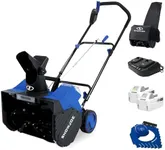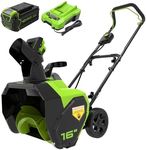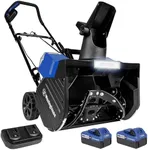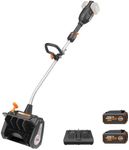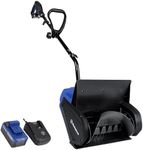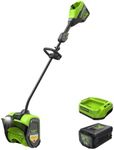Buying Guide for the Best Cordless Snow Thrower
Choosing the right cordless snow thrower can make a big difference in how easily and efficiently you can clear snow from your driveway, sidewalks, and other areas. When selecting a cordless snow thrower, it's important to consider several key specifications to ensure you get a model that fits your needs. Understanding these specs will help you make an informed decision and find the best product for your specific situation.Battery LifeBattery life refers to how long the snow thrower can operate on a single charge. This is important because it determines how much area you can clear before needing to recharge. Battery life can vary widely, with some models offering as little as 20 minutes and others providing up to an hour or more. If you have a large area to clear, look for a model with longer battery life or consider purchasing an extra battery for extended use. For smaller areas, a shorter battery life may be sufficient.
Clearing WidthClearing width is the width of the path that the snow thrower can clear in a single pass. This is important because a wider clearing width means you can clear snow more quickly. Clearing widths typically range from about 12 inches to 24 inches. If you have a large driveway or wide sidewalks, a model with a wider clearing width will save you time and effort. For smaller areas or narrow pathways, a narrower clearing width may be more maneuverable and easier to handle.
Clearing DepthClearing depth refers to the maximum height of snow that the snow thrower can handle in one pass. This is important for dealing with heavy snowfall. Clearing depths can range from around 6 inches to over 12 inches. If you live in an area that experiences heavy snowfall, look for a model with a greater clearing depth to ensure it can handle the snow accumulation. For areas with lighter snowfall, a smaller clearing depth may be adequate.
Throw DistanceThrow distance is how far the snow thrower can throw the snow it clears. This is important for ensuring that the snow is moved far enough away from the cleared area. Throw distances can range from about 10 feet to over 30 feet. If you need to move snow a significant distance away from your driveway or sidewalks, look for a model with a longer throw distance. For smaller areas or if you don't need to move the snow far, a shorter throw distance may be sufficient.
WeightWeight refers to how heavy the snow thrower is. This is important for ease of use and maneuverability. Lighter models are easier to handle and push, especially for longer periods. Weights can range from around 20 pounds to over 50 pounds. If you need to clear large areas or have physical limitations, a lighter model may be more suitable. For smaller areas or if you don't mind a bit of extra effort, a heavier model may offer more power and durability.
Noise LevelNoise level refers to how loud the snow thrower is during operation. This is important for comfort and consideration of your neighbors. Noise levels can vary, with some models being relatively quiet and others being quite loud. If you live in a densely populated area or prefer a quieter machine, look for models that are specifically designed to operate more quietly. If noise is not a major concern for you, this spec may be less important.
Ease of UseEase of use encompasses features that make the snow thrower more user-friendly, such as adjustable handles, easy start mechanisms, and intuitive controls. This is important for ensuring that you can operate the machine comfortably and efficiently. Look for models with features that match your preferences and physical capabilities. If you have specific needs, such as ergonomic handles or simple controls, prioritize these features to enhance your overall experience.


